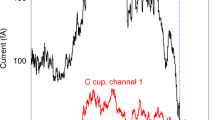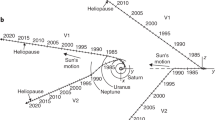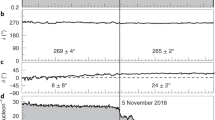Abstract
Over a two-year period, Voyager 1 observed a gradual slowing-down of radial plasma flow in the heliosheath to near-zero velocity1 after April 2010 at a distance of 113.5 astronomical units from the Sun (1 astronomical unit equals 1.5 × 108 kilometres). Voyager 1 was then about 20 astronomical units beyond the shock that terminates the free expansion of the solar wind and was immersed in the heated non-thermal plasma region called the heliosheath. The expectation from contemporary simulations2,3 was that the heliosheath plasma would be deflected from radial flow to meridional flow (in solar heliospheric coordinates), which at Voyager 1 would lie mainly on the (locally spherical) surface called the heliopause. This surface is supposed to separate the heliosheath plasma, which is of solar origin, from the interstellar plasma, which is of local Galactic origin. In 2011, the Voyager project began occasional temporary re-orientations of the spacecraft (totalling about 10–25 hours every 2 months) to re-align the Low-Energy Charged Particle instrument on board Voyager 1 so that it could measure meridional flow. Here we report that, contrary to expectations, these observations yielded a meridional flow velocity of +3 ± 11 km s−1, that is, one consistent with zero within statistical uncertainties.
This is a preview of subscription content, access via your institution
Access options
Subscribe to this journal
Receive 51 print issues and online access
$199.00 per year
only $3.90 per issue
Buy this article
- Purchase on Springer Link
- Instant access to full article PDF
Prices may be subject to local taxes which are calculated during checkout



Similar content being viewed by others
References
Krimigis, S. M., Roelof, E. C., Decker, R. B. & Hill, M. E. Zero outward flow velocity for plasma in a heliosheath transition layer. Nature 474, 359–361 (2011)
Pogorelov, N. V., Borovikov, S. N., Zank, G. P. & Ogino, T. Three-dimensional features of the outer heliosphere due to coupling between the interstellar and interplanetary magnetic fields. III. The effects of solar rotation and activity cycle. Astrophys. J. 696, 1478–1490 (2009)
Borovikov, S. N., Pogorelov, N. V., Burlaga, L. F. & Richardson, J. D. Plasma near the heliosheath: observations and modeling. Astrophys. J. 728, L21–L26 (2011)
Gleeson, L. J. & Axford, W. I. The Compton-Getting effect. Astrophys. Space Sci. 2, 431–437 (1968)
Richardson, J. D. & Wang, C. Plasma in the heliosheath: 3.5 years of observations. Astrophys. J. 734, L21–L24 (2011)
Acknowledgements
This work was supported at The Johns Hopkins University Applied Physics Laboratory by NASA contract NNN06AA01C. We thank J. Aiello for his assistance with our graphical presentation. We are grateful to the staff of the Voyager project for performing the Voyager 1 roll manoeuvres that made our analyses possible.
Author information
Authors and Affiliations
Contributions
R.B.D. performed the data analysis and contributed to the text; S.M.K. contributed to the text; E.C.R. contributed to the text and provided theory interpretation; and M.E.H. analysed elemental composition.
Corresponding author
Ethics declarations
Competing interests
The authors declare no competing financial interests.
Rights and permissions
About this article
Cite this article
Decker, R., Krimigis, S., Roelof, E. et al. No meridional plasma flow in the heliosheath transition region. Nature 489, 124–127 (2012). https://doi.org/10.1038/nature11441
Received:
Accepted:
Published:
Issue Date:
DOI: https://doi.org/10.1038/nature11441
This article is cited by
-
Future Exploration of the Outer Heliosphere and Very Local Interstellar Medium by Interstellar Probe
Space Science Reviews (2023)
-
The Early History of Heliospheric Science and the Spacecraft That Made It Possible
Space Science Reviews (2022)
-
The Structure of the Global Heliosphere as Seen by In-Situ Ions from the Voyagers and Remotely Sensed ENAs from Cassini
Space Science Reviews (2022)
-
Energetic charged particle measurements from Voyager 2 at the heliopause and beyond
Nature Astronomy (2019)
-
Voyager 2 plasma observations of the heliopause and interstellar medium
Nature Astronomy (2019)
Comments
By submitting a comment you agree to abide by our Terms and Community Guidelines. If you find something abusive or that does not comply with our terms or guidelines please flag it as inappropriate.



